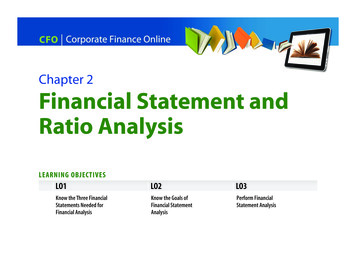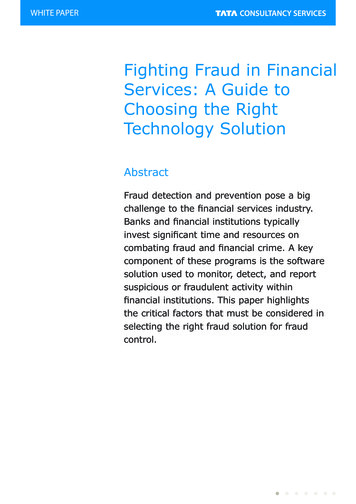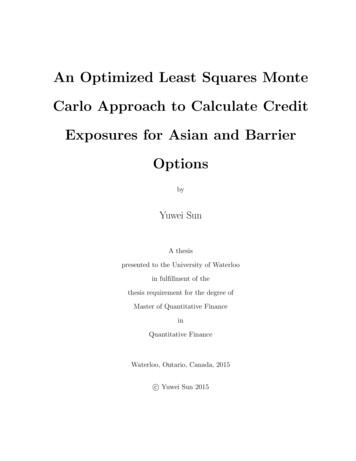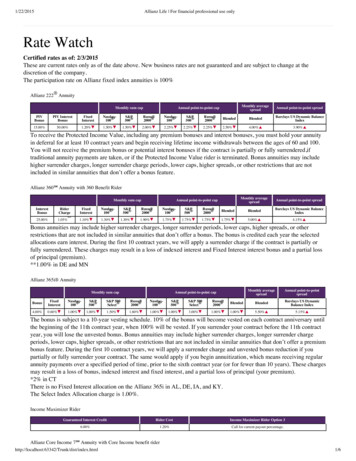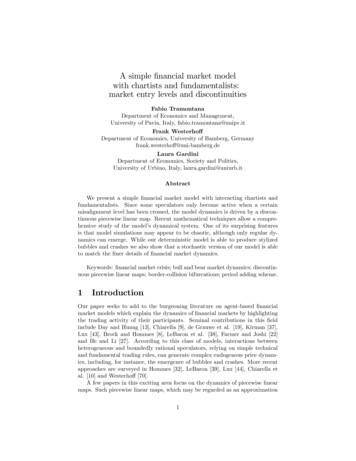
Transcription
A simple nancial market modelwith chartists and fundamentalists:market entry levels and discontinuitiesFabio TramontanaDepartment of Economics and Management,University of Pavia, Italy, fabio.tramontana@unipv.itFrank Westerho Department of Economics, University of Bamberg, Germanyfrank.westerho @uni-bamberg.deLaura GardiniDepartment of Economics, Society and Politics,University of Urbino, Italy, laura.gardini@uniurb.itAbstractWe present a simple nancial market model with interacting chartists andfundamentalists. Since some speculators only become active when a certainmisalignment level has been crossed, the model dynamics is driven by a discontinuous piecewise linear map. Recent mathematical techniques allow a comprehensive study of the model’s dynamical system. One of its surprising featuresis that model simulations may appear to be chaotic, although only regular dynamics can emerge. While our deterministic model is able to produce stylizedbubbles and crashes we also show that a stochastic version of our model is ableto match the ner details of nancial market dynamics.Keywords: nancial market crisis; bull and bear market dynamics; discontinuous piecewise linear maps; border-collision bifurcations; period adding scheme.1IntroductionOur paper seeks to add to the burgeoning literature on agent-based nancialmarket models which explain the dynamics of nancial markets by highlightingthe trading activity of their participants. Seminal contributions in this eldinclude Day and Huang [13], Chiarella [9], de Grauwe et al. [19], Kirman [37],Lux [43], Brock and Hommes [8], LeBaron et al. [38], Farmer and Joshi [22]and He and Li [27]. According to this class of models, interactions betweenheterogeneous and boundedly rational speculators, relying on simple technicaland fundamental trading rules, can generate complex endogenous price dynamics, including, for instance, the emergence of bubbles and crashes. More recentapproaches are surveyed in Hommes [32], LeBaron [39], Lux [44], Chiarella etal. [10] and Westerho [70].A few papers in this exciting area focus on the dynamics of piecewise linearmaps. Such piecewise linear maps, which may be regarded as an approximation1
of more complicated nonlinear maps, have the advantage that they often allowfor a deeper analytical study of the underlying dynamical system, and thusadvance our understanding of what is driving the dynamics of nancial markets.For examples, see the asset pricing models of Huang and Day [33], Day [16],Huang et al. [34] and Tramontana et al. [67].Our model, representing a stylized speculative market with interacting chartistsand fundamentalists, also has a piecewise linear structure1 . The reason for thisis that we assume that while some speculators are always active in the market,others only become active when a certain misalignment level has been crossed.Since we assume otherwise linear technical and fundamental trading rules, themodel consists of three disconnected branches. The inner regime is due to thetransactions of speculators who are always active; the two outer regimes dependon the joint trading behavior of all market participants.From a mathematical point of view, the peculiarity of our model is that although numerically we can observe trajectories that may look chaotic, chaoticbehavior cannot occur. Instead, only regular dynamics are possible, as thetrajectories are either periodic or quasiperiodic. However, both cases are structurally unstable, as they are never persistent under a parameter variation. Itshould also be noted that discontinuous piecewise linear maps have not yet beenthoroughly studied. Despite their simplicity, they can, however, lead to surprising new insights. We hope that our paper will advance our knowledge of suchmaps.From an economic point of view, our simple deterministic model is able toexplain, in a qualitative sense, the excess volatility and the disconnect puzzle –which are two of the most challenging and crucial puzzles in international nance(see, e.g. Shiller [62]). We nd this rather interesting since the only assumptionrequired for this is that, in an otherwise linear world, there are di erent marketentry levels for certain types of speculators. This assumption, which appearsquite natural to us, is already su cient for creating endogenous price dynamics.For instance, the dynamics of our model may evolve as follows. Close to thefundamental value, orders of optimistic chartists may start a bubble process.But once a certain misalignment level has been crossed, additional fundamentaltraders enter the market. Their orders may trigger a moderate price correctionor even a stronger crash. After the fundamentalists have left the market, theremaining chartists may optimistically initiate the next bubble. However, theirmood may also have turned pessimistic. In this case, they reinforce the crash. Itis again the market entry of additional fundamentalists which pushes prices backto fundamental values. Moreover, we demonstrate that a stochastic version ofour model is able to match the statistical properties of nancial markets in nerdetail. In particular, our stochastic model version is able to produce bubblesand crashes, excess volatility, fat-tailed return distributions, uncorrelated pricechanges and volatility clustering, thereby explaining some of the most importantstylized facts of nancial markets.1 Note that there is abundant empirical evidence, summarized by Menkho and Taylor [50],which supports the view that speculators indeed rely on technical and fundamental tradingrules.2
After these introductory remarks, the plan of the paper is as follows. Insection 2 we talk about the role of piecewise linear maps in nonlinear science.In section 3, we introduce our model and describe some preliminary properties ofits underlying dynamical system. In section 4, we start to investigate the modelin more detail. Since di erent parameter assumptions yield di erent maps, theanalysis stretches over sections 4 to 5. In Section 6 we build a stochastic versionof our model, showing how it can mimic some stylized facts of actual nancialmarkets. Finally, section 7 concludes the paper.2Background for the role of piecewise linearmaps in nonlinear scienceIt is well-known that several models in various scienti c areas are representedby piecewise smooth dynamical systems. The essential feature in piecewisesmooth dynamical systems, either continuous or discontinuous, is the presenceof a change of de nition in the functions de ning the map under study, whena suitable border is met or crossed. This is at the basis of the existence ofborder collision bifurcations, which have been introduced (although not usingthis term and starting with the properties of the skew tent map) by Nusse andYorke [54, 55], Maistrenko et al. [47], Maistrenko et al. [48] and Maistrenkoet al. [49]. However, also in early works by Leonov [40, 41] and Mira [52,53] several properties of piecewise linear discontinuous maps have already beendescribed, which, in turn, have recently been revisited and successfully improvedby Gardini et al. [25].Mathematical insights in this area are important since these kinds of systemshave recently found a wide use in several applied elds. We recall, for example,the books by Banerjee and Verghese [4], Zhusubaliyev and Mosekilde [72] anddi Bernardo et al. [20]. In particular, piecewise smooth systems are appliedin power electronic circuits (Halse et al. [26], Banerjee et al. [3]), impactingsystems (Nusse et al. [56], Ing et al. [35], Sharan and Banerjee [61], to cite afew), piecewise smooth nonlinear oscillators (Pavlovskaia et al. [58], Pavlovskaiaand Wiercigroch [59]), cryptography (de Oliveira and Sobottka et al. [57] andLi et al. [42]) and in many other applications (Banerjee and Grebogi [2], Sushkoet al. [63, 64]).But there are also many application of continuous and discontinuous piecewise smooth maps in economics and nance. A pioneer in this eld has beenRichard Day, as e.g. Day [11, 15], Day and Shafer [12] and Day and Pianigiani[14], whose work has been continued in Metcaf [51] and Böhm and Kaas [5],among others. In this respect, it is also worth mentioning the contributionsby Hommes [28, 29], Hommes and Nusse [30] and Hommes et al. [31]. Further economic and nancial models can be found in Puu and Sushko [60] andTramontana et al. [65, 66].As we will see, the model considered in this work is quite special. On theone hand, it di ers from most papers listed above because it has two disconti-3
nuities. On the other hand, it di ers from some known bifurcation mechanismsof piecewise linear maps because of a particular, always satis ed, "stability condition", which only implies the existence of periodic and quasiperiodic dynamicbehaviors. In other words, as we will see, a chaotic motion never occurs andany small parameters’ variation leads to a cycle of di erent period (or quasiperiodic behavior). The main point is that the economic model here describedsurprisingly leads exactly to this class of maps.While our focus is on one-dimensional maps, we nally mention that piecewise linear or piecewise smooth maps in higher-dimensional spaces have alsobeen proposed in di erent areas of science and economics. Besides some of theaforementioned works, see, for instance, di Bernardo et al. [21], De et al. [17,18] and Banerjee et al. [1].3A discontinuous nancial market modelOverall, our nancial market model consists of rather standard building blocks,formalizing the behavior of a market maker, and four types of speculators. Aspecial feature of our model is that we assume that so-called type 1 chartistsand type 1 fundamentalists are always active in the market, whereas so-calledtype 2 chartists and type 2 fundamentalists only become active when pricesdeviate at least a certain minimum amount from fundamentals. Note that themore unbalanced a market becomes, the more attention it indeed receives, forinstance due to heightened media coverage. Popular examples in this respectinclude the dot-com bubble and the recent nancial crisis following the Lehmandebacle. On the one hand, this may trigger an additional in‡ow of chartistswhich optimistically/pessimistically speculate on a continuation of the currentbull/bear market. On the other hand, there may also be an additional in‡owof fundamentalists which believe they can pro t from a fundamental price correction. In this paper, we thus consider an attention-based market entry ofadditional traders. In Appendix A, however, we also provide an alternative,pro t-based market entry argument. Note that both arguments imply the samedynamical system.Since our simple model concentrates on transactions of heterogeneous speculators, it can, with some liberty, be seen as a stylized representation of a stock,commodity or foreign exchange market. The model will be presented in section2.1. In section 2.2, we will then discuss some properties of our piecewise linearmaps, and related maps, which are helpful for understanding and appreciate theproperties of our model.3.1Our model’s building blockThe rst building block of our model describes price adjustments. FollowingDay and Huang [13], we assume a market maker mediates transactions out ofequilibrium by providing or absorbing liquidity, depending on whether the excessdemand is positive or negative. In addition to clearing the market, the market4
maker quotes prices according to the following rulePt 1 Pt a DtC;1 DtF;1 DtC;2 DtF;2 ;(1)where P is the log price, a is a positive price adjustment parameter, and DtC;1 ,DtF;1 , DtC;2 and DtF;2 are the orders of the four types of speculator. Accordingly, excess buying drives the price up and excess selling drives it down. Forsimplicity, yet without loss of generality, we set scaling parameter a equal to 1.Chartists believe in the persistence of bull and bear markets. The orders oftype 1 chartists are therefore given byDtC;1 c1 (PtP );(2)1where c is a positive reaction parameter and P stands for the asset’s (constant)log fundamental value. Hence type 1 chartists submit buying orders in bullmarkets and selling orders in bear markets2 .The trading behavior of fundamentalists is exactly contrary to the tradingbehavior of chartists. We formalize the orders of type 1 fundamentalists byDtF;1 f 1 (PPt ) ;(3)1where f is a positive reaction parameter. Clearly, (3) generates buying orderswhen the market is overvalued and generates selling orders when it is undervalued.What type 1 chartists and type 1 fundamentalists have in common is thatthey are almost always active. Once they perceive a mispricing, they starttrading. Type 2 chartists and type 2 fundamentalists are di erent to them inthe sense that they only become active when the misalignment exceeds a certain critical threshold level. As already mentioned, we assume in our modelan attention-based market entry of type 2 traders (and Appendix A develops apro t-based market entry argument, leading exactly to the same demand function). The orders of type 2 chartists and type 2 fundamentalists are thereforerepresented byDtC;2 0c2 (PtP )if jPt P j zif jPt P j z(4)DtF;2 0f 2 (PPt )if jPt P j zif jPt P j z(5)andrespectively. Again, reaction parameters c2 and f 2 are positive and the aforementioned threshold level is given by z 0.It is convenient to express the model in terms of deviations from its fundamental value. Using auxiliary variable Xt Pt P and combining (1) to (5)yields(1 c1 f 1 )Xtif jXj zXt 1 ;(6)(1 c1 f 1 c2 f 2 )Xtif jXj z2 This building block also goes back to Day and Huang [13]. Note that Boswijk et al. [6]and Westerho and Franke [71] report empirical support for such kind of trading behavior.5
which is a one-dimensional map consisting of three linear, disconnected straightlines.Furthermore, it is useful to introduce de nitions S 1 c1 f 1 and S 2 2cf 2 . Note rst that S 1 and S 2 can take any values. A positive (negative)value of S 1 means that type 1 chartists are more (less) aggressive than type 1fundamentalists. Of course, the same interpretation holds for S 2 and type 2speculators: a positive (negative) value of S 2 now means that type 2 chartistsare more (less) aggressive than type 2 fundamentalists.At rst sight, it might appear peculiar that type 2 chartists and type 2fundamentalists become active simultaneously when the distance between theprice and the fundamental value becomes larger than z and, indeed, a moregeneral model might allow for two di erent threshold levels (which would resultin a map with ve linear branches). However, in an even simpler version of ourmodel we can have any positive value for S 2 if we assume that there are only type2 chartists and any negative value for S 2 if we assume that there are only type2 fundamentalists. As we shall see later on, the latter speci cation, implyingadditional fundamentalists, is particularly interesting (and economically quitereasonable). For the moment, however, we shall stick to the more general setupwhich includes both type 2 chartists and type 2 fundamentalists.To simplify the notation even further, let us write X 0 Xt 1 and X Xt .Then (6) can be expressed asF : X0 (1 S 1 )X(1 S 1 S 2 )XififjXj z:jXj z(7)This is the map we explore in detail in the rest of the paper.3.2Some preliminary propertiesFirst, however, it is helpful to contrast some properties of map (7) with thoseof the following mapF : X0 (1 S 1 )X E(1 S 1 S 2 )XififjXj z;jXj z(8)where the extra parameter E can be positive or negative3 .A rst property is that parameter z is a scale variable. In fact, by using thechange of variable x X z and de ning the aggregate parameter M E z;our model in (8) becomesF : x0 (1 S 1 )x M(1 S 1 S 2 )xififjxj 1:jxj 1(9)That is, we have the followingProperty 1. The map in (8) is topologically conjugated to the map in (9).3 Note that map (8) with E 6 0 corresponds to a nancial market model which is studiedin Tramontana et al. [68].6
Note that M can be positive, negative or zero. However, the two cases witha positive and negative sign of M are topologically conjugated to one another.We have the followingProperty 2. The map F in (9) with M 0 is topologically conjugated withthe same map F and M 0.In fact, by using the change of variable y x, the map in (9) leads toF : y0 (1 S 1 )y M(1 S 1 S 2 )yififjyj 1:jyj 1(10)Clearly, the property holds also for map F in (8) with the sign of E. Hence,model (9) can be expressed as:8ifx 1 g(x) (1 S 1 S 2 )x0f (x) (1 S 1 )x Mif1 x 1 ;(11)F : x :g(x) (1 S 1 S 2 )xifx 1and is represented by a one-dimensional piecewise linear discontinuous map,with two discontinuity points.Investigating dynamics of this kind of map is quite new, and not yet fullyunderstood. We can therefore have some generic dynamic properties for ourclass of maps, which are related to the piecewise linear structure (see Tramontana et al. [68]). As we shall see, the case with M 0 is very special. Thenumerical simulations of the observed dynamics may lead to incorrect conclusions, re‡ecting a sequence of states very close to chaotic behavior, althoughno chaos can occur. In fact, this case leads to a non-chaotic map with peculiarproperties, with regular dynamics, either being periodic or quasiperiodic, andwill be completely investigated in this paper.By contrast, when M 6 0; the dynamic behavior generally includes attracting cycles (structurally stable, as persistent for variation of each parameter insome interval) or truly chaotic dynamics (also structurally stable or robust, i.e.persistent under parameter variation). The most important property for thesepiecewise linear maps is that the appearance of cycles cannot occur via a fold(or tangent) bifurcation, as is usual in smooth maps. Instead, a cycle can appear/disappear only via a border collision bifurcation. This term, initially usedin papers by Nusse and Yorke [54,55], is now used extensively in the literatureof piecewise smooth systems. A cycle undergoes a border collision bifurcationwhen one of its periodic points merges with a discontinuity point.Even if map (9) can generate cycles with periodic points in two or three ofits partitions, there are only two functions involved, so that the eigenvalue ofa cycle depends only on the number of periodic points in which functions f (x)and g(x) are applied. Moreover, the ‡ip bifurcations are not the usual ones (werecall that for smooth maps it is associated with the appearance of a stable cycleof double period). In piecewise linear maps only degenerate ‡ip bifurcations canoccur, so that at the bifurcation value a whole segment of cycles of doubleperiod exists, stable but not asymptotically stable. The dynamic e ects, after7
the bifurcation, are not uniquely de ned. It is possible to have several kindsof dynamics, but often this bifurcation leads to chaotic sets, that is to cyclicchaotic intervals (see Sushko and Gardini [64]). Thus the following propertyholds:Property 3. A structurally stable cycle of map F in (9) can appear/disappearonly via a border collision bifurcation. The eigenvalue of a cycle having p periodic points in the middle region ( jxj 1) and q outside ( jxj 1) is given by (1 S 1 )p (1 S 1 S 2 )q : Only degenerate-type ‡ip bifurcations can occur.Moreover, another property of map (9) is also immediate, and excludes caseswhich are unfeasible in the applied context, as leading to divergent trajectories.We know from property 3 that when both slopes of functions f (x) and g(x)are in modulus higher than 1, then all of the possible cycles are unstable, asj j 1: In these cases, a piecewise linear map can only have chaotic dynamics(when bounded trajectories exist) or divergent trajectories. However, due tothe particular structure of our map, when j1 S 1 j 1 and j1 S 1 S 2 j 1,we cannot have bounded dynamics because function g(x) is linear. This impliesthat whatever the dynamics in the range jxj 1, where the map is a ne, in a nite number of iterations any not xed trajectory enters the region with jxj 1;where it depends on the iterations of an expanding linear function (g(x); thegraph of which is through the origin). The length of the interval bounded by0 and xt can therefore only increase at each step. The unique possible existingcycle is thus an unstable xed point. Hence we have proved the followingProperty 4. Consider map F in (9) with j1 S 1 j 1 and j1 S 1 S 2 j 1:Then any initial condition di erent to the unstable xed point (if existing) hasa divergent trajectory.Economically, j1 S 1 j 1 means either that type 1 chartists are slightly moreaggressive than type 1 fundamentalists (S 1 0) or that type 1 fundamentalistsare considerably more aggressive than type 1 chartists (S 1 2). Moreover,j1 S 1 S 2 j 1 may be interpreted in the sense that the joint impact oftype 1 and type 2 chartists dominates, at least slightly, over the joint impact oftype 1 and type 2 fundamentalists or that the joint impact of type 1 and type2 fundamentalists is much stronger than the joint impact of type 1 and type2 chartists. We learn from this, furthermore, that not only chartists but alsofundamentalists can contribute to market instability.In the statement of property 3 we considered structurally stable cycles, whichcan occur only for M 6 0: Depending on the values of the parameters, as suchpositive or negative slopes of functions f and g, we can have di erent dynamicproperties. The possible outcomes associated with M 6 0 has been investigatedin Tramontana et al. [68], while the dynamics existing when M 0 is the objectof the present study. As already remarked, the case M 0 is special as onlystructurally unstable dynamics, either periodic or quasiperiodic, can exist.8
4Non-chaotic regime at M 0Let us consider map F in (11), for the particular case M 0; say F0 (whichcorresponds to map F in (7) after the change of variable x X z):F0 : x0 f (x) (1 S 1 )xg(x) (1 S 1 S 2 )xififjxj 1jxj 1(12)and keeping all of the possible values for the slopes of functions f (x) and g(x);that is (1 S 1 ) and (1 S 1 S 2 ) can be positive or negative and in modulushigher or smaller than 1. We can therefore consider the regions in the parameterspace (S 1 ; S 2 ), as summarized in Fig. 1. This map is a particular case of a classof dynamical systems, whose properties have been analyzed in Gardini andTramontana [24]. In this subsection we recall the main properties that hold forour speci c model.Before proceeding to comment on behavior in the parameter space, let usremark on one further property speci c to this case M 0, which holds in thephase space of variable x. Performing the change of variable y x, the mapis transformed into itself:y0 f (y) (1 S 1 )yg(y) (1 S 1 S 2 )yif jyj 1if jyj 1(13)which means that the phase space is symmetric with respect to the origin. Thatis: either a trajectory is symmetric with respect to the origin or the symmetricone also exists. This is particularly true for a periodic orbit. We have thereforeproved the followingProperty 5. Map F0 is invariant with respect to the change of variabley x: Thus a periodic orbit (x1 ; x2 ; :::xn ) either has points symmetric withrespect to the origin or ( x1 ; x2 ; ::: xn ) is also a periodic orbit.9
Fig. 1 Two-dimensional parameter space (S 1 ; S 2 ) at M 0: The regions arebounded by straight lines S 1 0; S 1 2; S 2 S 1 ; S 2 S 1 2: LineS 2 S 1 1 leads only to a qualitative change.Let us now consider the parameter space. In Fig. 1 the regions with divergentdynamics are those already introduced in Property 4; those associated with thestability of the xed point in origin O (0; 0) are described in the followingProperty 6. Consider map F0 with j1 S 1 j 1: For j1 S 1 S 2 j 1 xed point O in the origin is globally attracting. For j1 S 1 S 2 j 1 xedpoint O is attracting, with basin of attraction B(O) ] 1; 1[; while any i.c. xwith jxj 1 has a divergent trajectory.In fact, if j1 S 1 S 2 j 1, then any initial condition in the range jxj 1has a trajectory which, in a few iterations, enters range jxj 1 from which thetrajectory converges to the origin. This leads to the red region in Fig. 1, whilethe dynamics in the other regions of the vertical strip of Fig. 1 are associatedwith j1 S 1 S 2 j 1: In such a case, any initial condition in the range jxj 1has a trajectory which converges to the origin, as it is locally stable and themap is linear in that region, while any initial condition in range jxj 1; due tothe structure of the piecewise linear map, has a trajectory which is divergent.Similar to before, these cases can be interpreted economically. For instance,the unique xed point of the model, where the price is equal to its fundamentalvalue, is globally stable if type 1 fundamentalists are more aggressive than type1 chartists, but also not too aggressive ( 2 S 1 0) and also if the jointimpact of both types of fundamentalists is stronger, yet not very much stronger(S 1 S 2 has to remain larger than -2), than the joint impact of both types ofchartist.The particular cases with (1 S 1 ) 1 and (1 S 1 ) 1; that is S 1 0and S 1 2; are degenerate bifurcations (as described in Sushko and Gardini[64]). For S 1 0 there is segment ] 1; 1[ lled with xed points; for S 1 2segment ] 1; 1[ is lled with period 2 cycles. At these degenerate bifurcations,the existing cycles are stable but not asymptotically stable (i.e. they do notattract the trajectories of nearby points). After the bifurcation, for j1 S 1 j 1;the result depends on the modulus of (1 S 1 S 2 ): As we have seen, forj1 S 1 S 2 j 1 only divergent dynamics can occur, while for j1 S 1 S 2 j 1an invariant absorbing interval J exists, given by:JJ [f ( 1); f (1)] [ (1 S 1 ); (1 S 1 )]; if (1 S 1 ) 1 [f (1); f ( 1)] [(1 S 1 ); (1 S 1 )]; if (1 S 1 ) 1;(14)attracting the trajectories of all points of the phase space outside J (and fromwhich a trajectory cannot escape). Thus the dynamics cannot be divergent.It follows that the particular cases left to our analysis are exactly those inthe green regions of Fig. 1, which is the main object of our work. As visiblefrom Fig. 1, the regions under investigation are really four di erent regions,associated with di erent values of the slopes of functions f (x) and g(x): For10
S 1 0, these include the two casesH1 (i)H1 (ii)::(1 S 1 ) 1; 0 (1 S 1 S 2 ) 1; increasing/increasing (15)(1 S 1 ) 1; 1 (1 S 1 S 2 ) 0; increasing/decreasing,while for S 1 H2 (i) :H2 (ii) :2, these include the two cases(1 S 1 ) (1 S 1 ) 1; 0 (1 S 1 S 2 ) 1; decreasing/increasing(16)1; 1 (1 S 1 S 2 ) 0; decreasing/decreasing.Again, these four regions have a simple economic interpretation. For instance, case H1 (i) states that type 1 chartists are more aggressive than type 1fundamentalists, but that the joint impact of both types of fundamentalist isstronger than the joint impact of both types of chartist. The di erence betweencase H1 (i) and case H1 (ii) is that the joint impact of both types of fundamentalist is stronger in case H1 (ii), yet also not too much stronger (S 1 S 2 has toremain above -2). Obviously, the main di erence between the two H1 cases andthe two H2 cases is then that the H2 cases imply that type 1 fundamentalistsare so aggressive that they destabilize the steady state within the inner regime.Global stability will, however, still be maintained as long as j1 S 1 S 2 j 1.Given the assumption S 1 2, it is then clear that aggressive type 2 chartistsare required to prevent price explosions.In the next sections, we shall fully explain cases H1 (i) and H1 (ii), which willalso be used to explain cases H2 : Let us rst introduce the peculiar property ofour model described by map F0 ; which is stated in the followingProperty (S). Consider map F0 with j1 S 1 j 1 and j1 S 1 S 2 j 1:Then the following equalities hold :(S) : fg(1) g f (1) ; fg( 1) g f ( 1):(17)In fact, this property can be immediately veri ed from the de nition of mapF0 given in (12): we have g f (1) (1 S 1 S 2 )(1 S 1 ) and f g(1) (1 S 1 )(1 S 1 S 2 ) as well as g f ( 1) (1 S 1 S 2 )(1 S 1 ) andf g( 1) (1 S 1 )(1 S 1 S 2 ); so that the properties in (17) hold.Property (S) is an important property because it leads to a stability regimewhich is, however, structurally unstable, that is: any small change in any parameter of the model leads to a di erent dynamic behavior. The importantdynamic property of map F in this case M 0 is exactly this Property (S)which, as we shall see, implies that an invariant set I exists, and each pointof I has a unique rank-1 preimage in the set I itself. This property (thateach point of I has a unique rank-1 preimage in the set I itself) is exactly theproperty of a linear rotation on a circle and, depending on a suitable rotationnumber, which in our case is associated with the values of parameters S 1 andS 2 ; a trajectory may be either periodic (in which case all of the points of theinterval I are periodic of the same period), or quasiperiodic and dense in theinterval I. In case H1 (i) (increasing/increasing), considered in the next section,11
there are two disjoint invariant absorbing intervals: I R and I L . In case H1 (ii)(increasing/decreasing), considered thereafter, the invariant set I will be theunion of two intervals.Let us analyze the conditions leading to periodic dynamics. Let x be a pointbelonging to the absorbing set I of map F0 , di erent to a discontinuity point.Then it can be a periodic point of rst period n if n is the minimum integersuch that F0n (x) x: Let p be the number of periodic points of the n cycle inthe region jxj 1 and q in the region jxj 1, (p q) n. T
After these introductory remarks, the plan of the paper is as follows. In section 2 we talk about the role of piecewise linear maps in nonlinear science. In section 3, we introduce our model and describe some preliminary properties of its underlying dynamical system. In section 4, we start to investigate the model in more detail.
